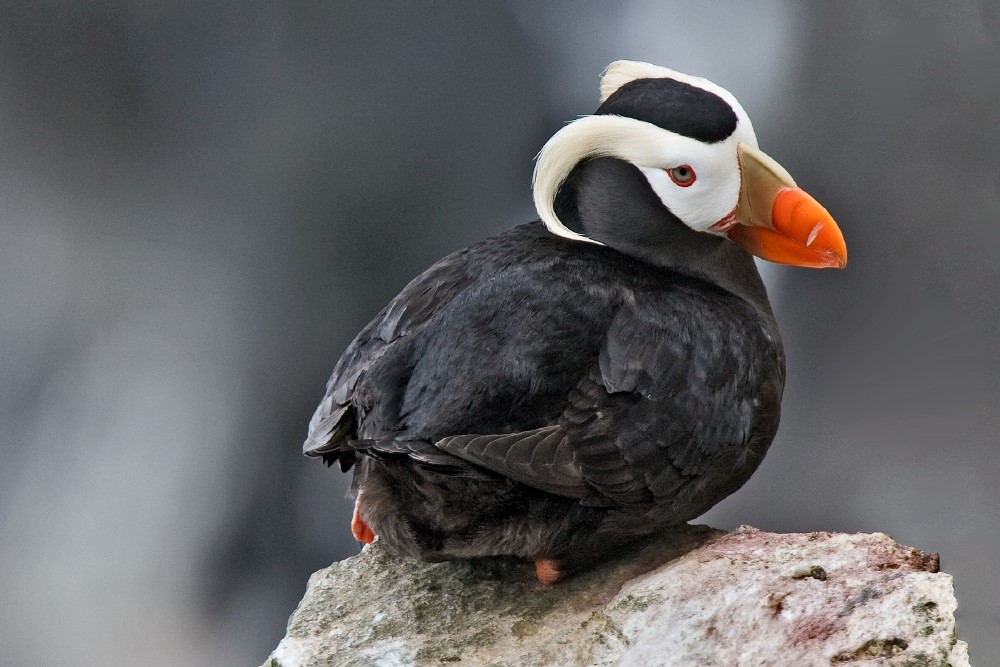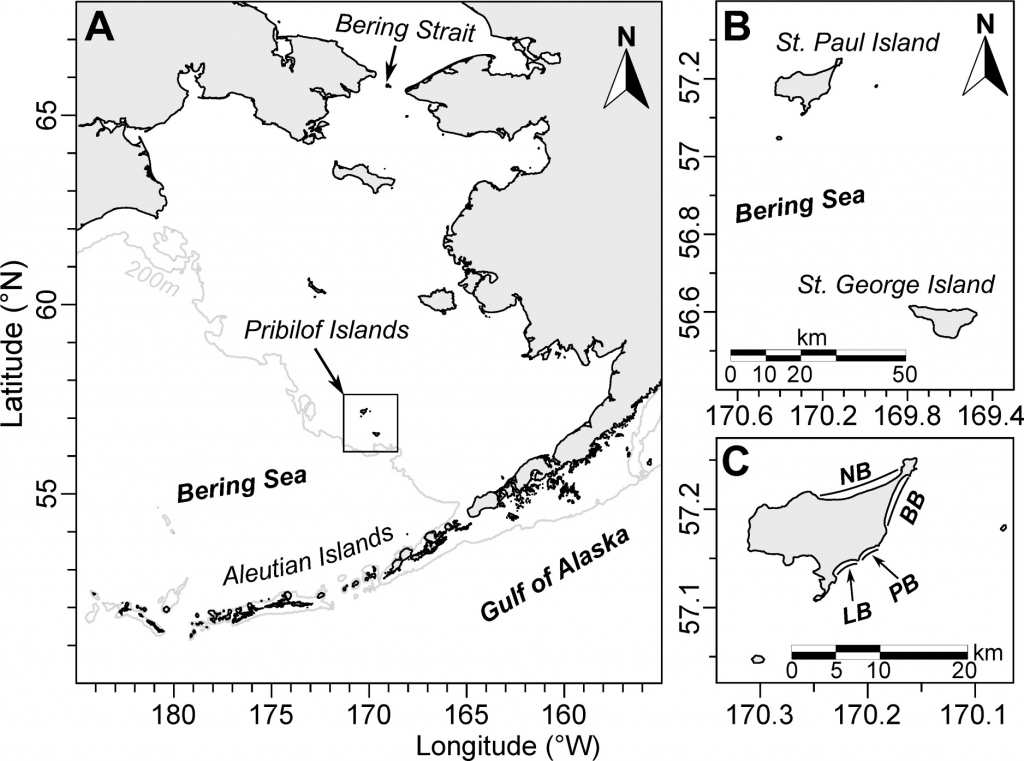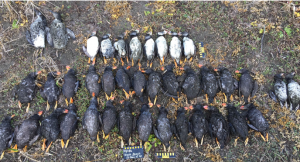Jones T, Divine LM, Renner H, Knowles S, Lefebvre KA, Burgess HK, et al. (2019) Unusual mortality of Tufted puffins (Fratercula cirrhata) in the eastern Bering Sea. PLoS ONE 14(5): e0216532. https://doi.org/10.1371/journal.pone.0216532
Mass mortality events (or MMEs) are incidents that kill a vast number of individuals in a short period of time. They’re often caused by disease, pollution, and other stressors interacting with one another in a perfect storm that wipes out nearly every individual in the group; and they differ from cyclical die-off events, like those experienced by seasonally emergent insects, in how extreme and unusual they are. Over the last decade, scientists have been sounding the alarm on what they say is a rise in the number of mass mortality events affecting many different species around the world.
MMEs aren’t just bad for the species experiencing them, they also carry dramatic consequences for the local ecosystem. In 2013, a mass mortality event involving a mysterious wasting disease killed off thousands of starfish along the California coast. While the event was certainly a disaster for the starfish population, it also reduced pressure on mussels, sea urchins, and other starfish prey species which, in turn, led to serious declines in the favourite food of the prey species – the vital kelp forests. In community ecology, we call these kinds of chain-reactions “knock-on effects”, where a dramatic change in one component of the system creates a response change in other components. With the potential to cause such dramatic knock-on effects, a reported rise in MMEs has many population and community ecologists worried for the continued health of our oceans and the marine ecosystems we depend on.

65X The Normal Death Rate
MMEs caused by disease outbreaks have been known to scientists for a long time, but it seems that more incidents, and more incidents with multiple causes, have been occurring over the last 30 or more years. Lately, the wildlife most often hit seem to be marine birds, fish, and invertebrates.
Over the winter of 2016-2017, hundreds of seabirds started washing ashore in the Pribilof Islands, off the coast of Alaska in the Bering Sea. Scientists had already been monitoring the islands’ beaches regularly when the MME hit, forming a baseline back to 2006 which gave them an idea of how many dead bird sightings were normal. When more than 65X the dead seabird baseline started washing up in 2016, made up of mostly Tufted Puffins and Crested Auklets, they knew something was off. In a recent article published in PlosOne, Jones et. al. describe the scene and suggest potential causes for the extreme event.
Birds as Environmental Indicators
Tufted Puffins are the largest of the world’s puffins species, living in coastal colonies and on oceanic islands from California to Alaska in the often harsh NE Pacific. In mid oceanic island chains, like the Pribilof Islands, they eat a mixture of fish and marine invertebrates, which they use their uniquely-adapted stout bodies to dive for. They raise their chicks in dense rocky colonies, burrowed into crevasses where they find safety from the elements and predators. (They’re also really cute, with a thick layer of fat and short wings better adapted to swimming than flying, making them adorably chubby and awkward). Like many other seabird species, puffins are particularly vulnerable to changes in a migrating food supply, weather, and, because they live so close together, disease. Spending so much time at sea and prefering island roosts for breeding, puffins that die of normal causes don’t usually wash up on the shore.

Seabirds make great environmental indicators; they feed at many different levels of the food chain (eating everything from plankton to fish, and even other birds), they have unique and very specific breeding requirements, they’re found over wide areas, and they react quickly and sometimes dramatically to environmental change, making them canaries in the coal mine that is our global ocean.
Researchers started collecting seabird carcasses from the Pribilof beaches soon after the birds were first noticed, taking photos of them so they could be correctly identified and their body condition assessed, and they continued counting the birds until the MME ended. Eight carcasses were sent away for further investigation, where the researchers examined the stomach contents of some of the birds and looked for signs of common bird-killers, like avian influenza or harmful algae toxins.
Tired and Starving
Most of the Pribilof carcasses were relatively intact, regardless of when they arrived at the beach. Birds that die at sea may float in the currents for months before they make land, decaying or getting picked up by scavengers on the way. The Pribilof MME lasted for most of the winter, with intact birds washing up regularly on the beaches, indicating that the mortality event was an ongoing incident and not something that happened over just a couple days.
Before the MME, Alcids (the group Puffins, Murres, and Auklets belong to) made up a very small proportion of found beached carcasses. In 2016 and 2017, they made up 90% of the findings. Laboratory analysis of the carcasses revealed that most of the beached Alcids were severely emaciated with shriveled pectoral muscles and little remaining fat. Most of the Tufted Puffins found were also in the middle of flight-feather molt, something seabirds go through seasonally to replace old and worn feathers.
It seems that the birds of the Pribilof colonies were starving in 2016, with additional stress added by the inconvenient timing of a molt in the case of the Tufted Puffins. Altogether, the researchers estimated that a total of 3,150 – 8,000 birds might have died, depending on how far reaching the event was. The researchers couldn’t be sure which breeding colonies the carcasses came from, but concluded that, if they came from key Shaiak Island colony, the 2016-2017 MME could have killed up to 72% of the local Tufted Puffin population.

A Changing Climate Leads to Changing Food Sources
Prior to the 2016-2017 MME, scientists monitoring marine species in the Bering Sea had noted a marked decline in fish and invertebrate species following unusual water temperatures. Euphausiids, an important invertebrate prey for Tufted Puffins, had shifted northward following the decline in sea ice cover. Pollock, which were also struggling to survive the changing conditions, had lost weight and become less nutritious for the Puffins. It’s likely that the onset of winter storms in 2016-2017 further stressed the birds, with January winds being particularly strong. Similar conditions have been blamed for other MMEs that took place in the Bering Sea in the 1980s and 90s.
So what’s next for the seabirds of the North? We know that the poles are warming faster than the rest of the world, and scientists have already documented the Northward migration of key prey species. Facing dwindling food sources, seabirds will have to either follow their prey or adapt to eating whatever is left at home. Considering that many seabirds require island habitats to successfully roost and breed, safe from weather and predators, migrating away from home may be a risky option for many species, including the Tufted Puffins. However, it can take species a very long time to adapt to changing environmental conditions and the current climate crisis is changing our Northern altitudes at an alarming rate. Are we witnessing the gradual demise of these species? What can we do to save the adorably chunky puffins?
More research is needed to fully understand the cumulative effects of warming waters, prey range shifts, and increased storm frequency and severity on seabird populations. In the meantime, initiatives that contribute to meaningful climate action are already long overdue. The puffins and other Arctic seabirds may not have the time to wait.
If you’d like to support conservation action for Puffins and other Alcids, check out the Audubon Puffin Project
Hi! I’m Rebecca Parker. I’m an ecologist and plant lover working in non-profit conservation in Nova Scotia Canada. I trained at Dalhousie and Ryerson University, where I completed a Masters in Environmental Science and Management. I like botany, wetlands, and wetland botany! On the sciencey side, I like to write about current topics in population and community ecology, but I’m also really interested in environmental outreach, how exposure to science and demographics affect environmental values and behaviours, and best practices for building community capacity in environmental stewardship. Check out my instagram for photos of the awesome nature I see through my work.

